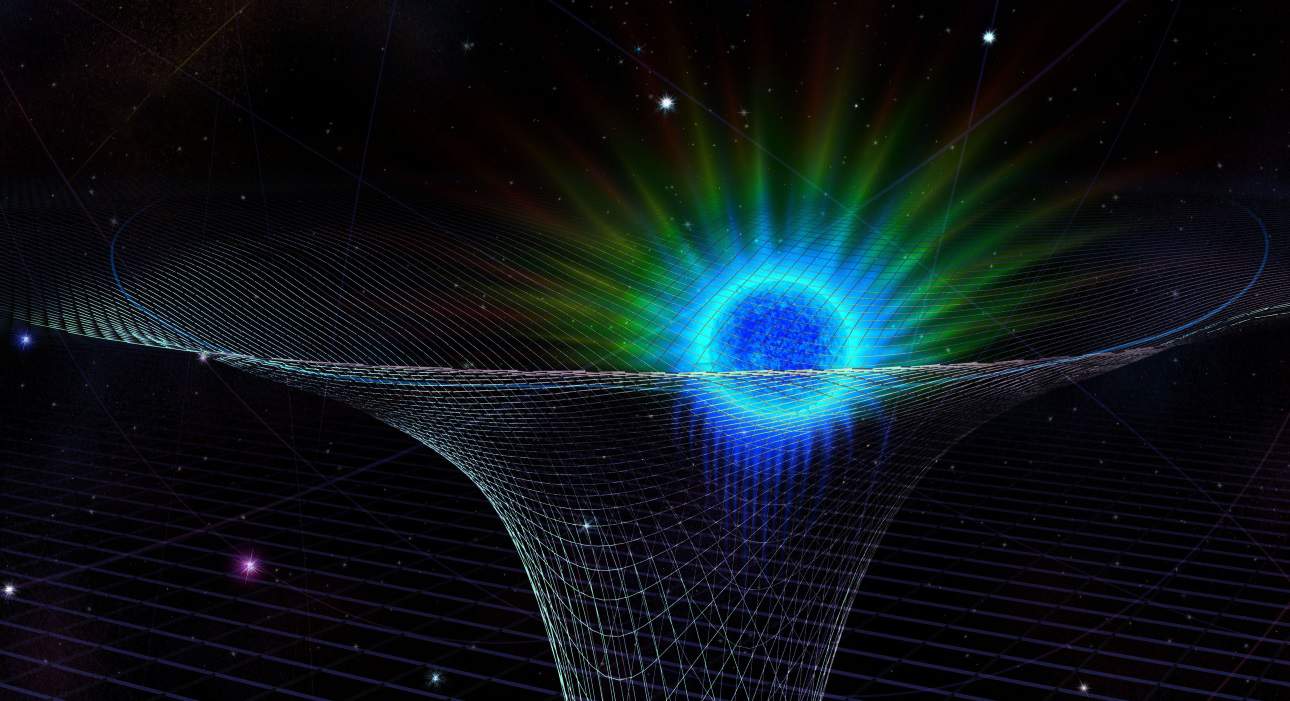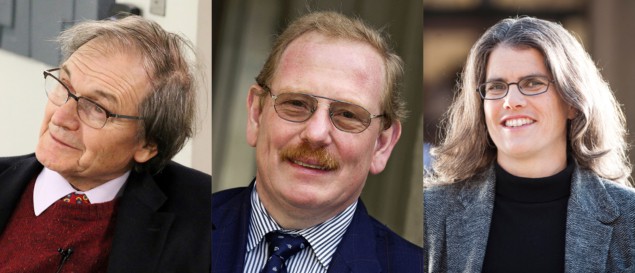Roger Penrose, Reinhard Genzel and Andrea Ghez bag the Nobel Prize for Physics
06 Oct 2020 Hamish Johnston
The 2020 Nobel Prize for Physics has been awarded to Roger Penrose, Reinhard Genzel and Andrea Ghez for their work on black holes.
The prize is worth 10 million Swedish krona (about $1.1 million) and half goes to Penrose, with Genzel and Ghez sharing the other half of the prize.
The Nobel Committee cites Penrose “for the discovery that black hole formation is a robust prediction of the general theory of relativity”, and Genzel and Ghez “for the discovery of a supermassive compact object at the centre of our galaxy”.
After the announcement was made this morning by the Royal Swedish Academy of Sciences, Ghez answered questions remotely from the US.
Doubt and excitement
When asked what went through her mind when she first thought there was a huge black hole lurking in the middle of the Milky Way, Ghez replied “The first thing was doubt that you’re really seeing what you think you’re seeing. Doubt and excitement – that feeling that you’re at the frontier of research.”
On being the fourth woman to win the physics Nobel prize, Ghez said “I’m thrilled to receive the prize and take very seriously the responsibility with being the fourth woman to win the Nobel prize. I hope I can inspire other young women into the field – it’s a field that has so many pleasures. And if you’re passionate about science there are so many things that can be done.”
Since the 18th century, physicists have speculated about the existence of objects so massive that even light cannot escape their gravitational pull. However, it was not until the early 20th century when Albert Einstein created his general theory of relativity that scientists had the mathematical tools to investigate black holes with mathematical precision.
Can black holes form?
But even then, there was confusion over whether a black hole could form in nature. One concern at the time was the idea that any departure from perfect spherical symmetry of an object could prevent it from collapsing to a singularity – a single point in space and time. This was an important consideration because rotating stars do not have spherical symmetry.
In 1965 Penrose developed new mathematical tools for describing how a star could collapse to a black hole and devised a rigorous proof that the formation of a black hole is entirely consistent with general relativity. In particular, he introduced the concept of the “trapped surface” – a closed 2D surface with the property that all light rays orthogonal to the surface converge when traced toward the future. A trapped surface is formed in the early stages of the gravitational collapse of a star and once it has formed, the system must collapse to a singularity, creating a black hole. Crucially, Penrose showed that this applies irrespective of the symmetry of the collapsing object.
As well as being the first major contribution to general relativity since Einstein, Penrose’s work inspired generations of astrophysicists and astronomers to work towards observing black holes.
“Renaissance in relativity”
“It was Penrose, more than anyone else, who triggered the renaissance in relativity in the 1960s through his introduction of new mathematical techniques,” says the UK’s Astronomer Royal, Martin Rees.
Also in the mid-1960s, astronomers and astrophysicists were beginning to think that light emitted from bright regions at the centres of some galaxies was created by matter falling into black holes that were millions or even billions of times more massive than the Sun. However, verifying that these active galactic nuclei (AGNs) contained black holes proved to be very difficult because telescopes did not have the resolution to distinguish between a black hole and a tight cluster of stars – which could also be lurking at the centres of galaxies.
A way around this problem is to study the motions of stars that orbit close to the AGN. If the stars are orbiting a black hole, their speeds should have a specific relationship with their distance from the black hole – as do planets orbiting the Sun. However, if the stars are orbiting a cluster of stars, a different speed–distance relationship is expected.
Highly elliptical orbit
Teams led by Ghez and Genzel studied a star that takes about 16 years to orbit the AGN at the centre of the Milky Way. The star has a highly elliptical orbit and gets to within 17 light-hours from the AGN. Independent analyses of the motion of the star by both teams suggests that it is orbiting an extremely compact object that with a mass of about 4 million Suns. The only reasonable interpretation of this is that there is a supermassive black hole at the centre of the galaxy.READ MORE

Laura Nuttall, who studies black-hole mergers at Portsmouth University told Physics World “It’s great to see Penrose, Ghez and Genzel recognized with the Nobel prize. Penrose is synonymous with black holes. His work in proving how black holes form, as well as their centre being a singularity, has opened so many fields, including that of searching for gravitational waves.”
She adds, “Ghez and Genzel’s work has also inspired many, such as the Event Horizon Telescope, which only released an image of a supermassive black hole last year. It’s wonderful, that their work is very much taken as a given today – of course black holes form from the collapse of matter and of course there’s a black hole at the centre of the galaxy. It’s easy to forget that this has not always been the case!”
Ghez was born in 1965 in the New York City, US. She received a BS in physics from the Massachusetts Institute of Technology in 1987 and a PhD at the California Institute of Technology in 1992. After a year at the University of Arizona, she moved to the University of California, Los Angeles in 1994 where she has remained since.READ MORE

Genzel was born in 1952 in Bad Homburg vor der Höhe, Germany. He studied physics at the University of Freiburg before completing a PhD in radio astronomy at the University of Bonn in 1978. He then moved to the US working first at the Harvard-Smithsonian Center for Astrophysics until 1980 and then the Space Sciences Laboratory at the University of California, Berkeley until 1985. After a year as a professor at the University of California, Berkeley, he became a director of the Max Planck Institute for Extraterrestrial Physics in 1986. Since 1999 Genzel has held a joint appointment between the Max Planck Institute for Extraterrestrial Physics and the University of California, Berkeley.
Penrose was born in 1931 in Colchester, UK. He did a BSc in mathematics at University College London before completing a PhD in algebraic geometry at the University of Cambridge in 1957. After spending time at Princeton and Syracuse universities in the US in 1959–1961, he returned to England to King’s College London before heading to the University of Texas at Austin in 1963–1964. Penrose then moved to Birkbeck College, London until 1973 before heading to the University of Oxford, where he has remained since.
from physicsworld.com 9/10/2020

Δεν υπάρχουν σχόλια:
Δημοσίευση σχολίου